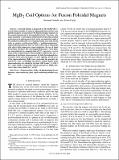MgB₂ Coil Options for Fusion Poloidal Magnets
Author(s)
Giunchi, Giovanni; Coppi, Bruno
DownloadGiunchi-2010-MgB2 coil options for fusion poloidal magnets.pdf (313.0Kb)
PUBLISHER_POLICY
Publisher Policy
Article is made available in accordance with the publisher's policy and may be subject to US copyright law. Please refer to the publisher's site for terms of use.
Terms of use
Metadata
Show full item recordAbstract
A hybrid solution is proposed for the IGNITOR research fusion machine by using of superconducting coils for some poloidal magnets, in association with high field copper magnets for the central solenoid and for the toroidal field coils. The choice to be made among the various superconductors is based on the materials performances in high magnetic field, on the mechanical strength of the conductors and on the cost of manufacturing large coils. In this study we analyze a coil based on MgB₂, a "medium temperature" superconducting material that we expect will avoid, in association with others high temperature superconductors, the use of liquid He in future machines. The external poloidal magnet, 5 m in diameter and subjected to a magnetic field of 5 T, represents a real test bench of the technical issues which should be addressed in the exploitation of the future fusion reactors. To fulfil the technical characteristics of the selected magnet we must optimize the fill factor of the superconducting MgB₂ wires, increasing the presently obtained 30% value. Accordingly, the effective current density in the superconducting wire should be of about 1500 A/mm[superscript 2] (@10 K, 5 T), a value which is compatible with the present best MgB₂ laboratory short wires, doped by C or SiC.
Date issued
2010-06Department
Massachusetts Institute of Technology. Department of PhysicsJournal
IEEE Transactions on Applied Superconductivity
Publisher
Institute of Electrical and Electronics Engineers
Citation
Giunchi, Giovanni, and Bruno Coppi. “MgB₂ Coil Options for Fusion Poloidal Magnets.” IEEE Transactions on Applied Superconductivity 20.3 (2010): 1610–1613. Web. ©2010 IEEE.
Version: Final published version
Other identifiers
INSPEC Accession Number: 11323405
ISSN
1051-8223
1558-2515